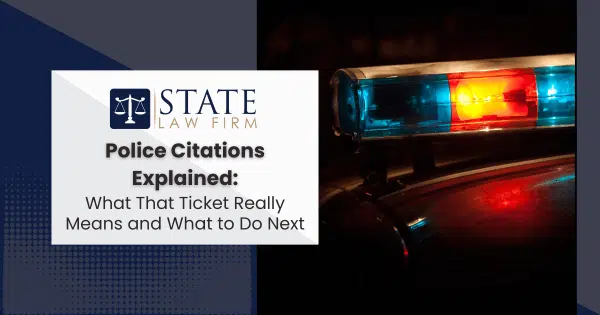Getting a ticket can feel both frustrating and confusing. The slip of paper an officer hands you is more than a bill. It is a formal notice of a legal accusation with a deadline and clear next steps. This guide breaks down what a police citation is, what happens after you receive one, and how to choose the option that best protects your license, your record, and your wallet.
Understanding Police Citations: Definition and Common Types
A police citation, often called a traffic ticket or notice to appear, is an official allegation that you violated a law. For most driving issues in California, citations are for infractions, which are less serious than misdemeanors or felonies but still carry fines and other consequences. Some violations, like reckless driving or driving under the influence, are criminal and can require a mandatory court appearance.
The most common citation categories include:
- Moving violations such as speeding, running a stop sign, or unsafe lane changes.
- Nonmoving or equipment violations, such as expired registration, broken lights, or missing insurance proof.
- Correctable or “fix-it” violations that can be dismissed if you repair the problem and show proof by the deadline.
- Misdemeanor traffic offenses may require you to appear in court in person.
No matter the type, your citation will list a deadline to respond and the court that has jurisdiction over the ticket. Ignoring the ticket is likely to make things worse.
What Happens When You Receive a Citation
After the stop, you will either receive a citation on the spot or by mail. Many California courts send a courtesy notice that explains your options, deadlines, and estimated fine amounts.
This notice often arrives a few weeks after the stop, but you are still responsible for the date printed on the ticket itself. If you do not get a notice, follow the instructions on your citation and contact the court listed there.
Missing your due date can trigger additional penalties, a new misdemeanor charge for failing to appear, and a driver’s license hold or suspension.
For minor infractions, you can often resolve the ticket without going to court. For more serious charges or any ticket marked “mandatory appearance,” plan on appearing before a judge or consulting a lawyer promptly.
Reading Your Citation: Key Details That Matter
Take five minutes to read your ticket carefully. The front and back usually include the information you need to make a sound decision:
- The exact violation and code section. This determines whether the charge is a correctable issue, an infraction, or a misdemeanor.
- Location, date, and time of the alleged offense. These details matter if you contest the ticket.
- Court name and address. This is where you will pay, request traffic school, or set a trial.
- Appear-by or due date. Mark this on your calendar immediately.
- Officer and agency information. You will need this if you later request records or evidence.
- Boxes for correctable violations. If marked, you may be able to fix the problem and request a dismissal with proof and a small administrative fee.
If anything is unclear, call the traffic division of the court listed on your citation. Most court websites also publish local instructions covering payment, traffic school enrollment, extensions, and how to contest.
Your Options After Receiving a Ticket: Pay, Fix, Traffic School, or Contest
You generally have four paths. The right one depends on the charge, your driving record, and your priorities.
1) Pay the ticket.
Paying is the simplest option, but it counts as a conviction. For moving violations, that usually means a point on your DMV record, which can raise insurance rates. Choose this only if the cost and downstream consequences are acceptable.
2) Fix-it tickets.
If your citation is marked as correctable, repair the issue by the deadline, get proof of correction from an approved agency, and submit it to the court with the required fee. When done correctly, the court can dismiss the charge. This is a cost-effective way to avoid points and keep your record clean.
3) Traffic school to make a point.
If eligible, you can complete a DMV-approved traffic violator school. For most noncommercial drivers, finishing traffic school on a qualifying moving violation prevents the point from appearing on your public driving record. Insurers usually cannot see that masked point, which helps keep premiums down. Eligibility rules and frequency limits apply, and certain violations do not qualify. You must plead guilty or no contest and pay the fine plus a traffic school fee. If you plan to fight the ticket, do not enroll until you understand how your court handles traffic school after trial.
4) Contest the ticket.
If you believe the officer got it wrong, or you want leverage to negotiate, you can plead not guilty and request a trial. California offers two ways to contest an infraction:
- Trial by written declaration. You present your defense in writing by a deadline, the officer submits a written statement, and a judicial officer decides the case without a hearing. If you lose, you can usually request a new in-person trial, called a trial de novo, within a short deadline.
- In-person trial. You or your lawyer appear, present evidence, question the officer, and argue the law. You may also ask the judge for a reduced fine or traffic school at the end if you are convicted, subject to eligibility.
Some courts require a bail deposit when you request a trial by written declaration. If you are found not guilty, the court returns the deposit. Check your court’s procedures and deadlines.
Consequences: Fines, Points, Insurance, and License Risk
Understanding the downstream effects helps you choose wisely.
- Fines and fees. The total you pay can include the base fine plus penalty assessments, court operations fees, and other surcharges. Courtesy notices usually show an estimated total.
- DMV points. Most moving violations are one point. Serious violations, such as hit and run or reckless driving, can be two points. Points add up under California’s Negligent Operator Treatment System. Accumulating too many points in a short period can trigger warning letters and, ultimately, a suspension with probation.
- Insurance impact. A public point on your driving record can raise premiums for years. Using traffic school on an eligible violation masks the point from your public record, which typically limits insurance fallout.
- Failure to appear. Missing your due date can lead to a separate misdemeanor charge, added fines, and a license hold. Take deadlines seriously.
- Commercial drivers and special rules. Convictions that occur in a commercial vehicle or for drivers who hold commercial licenses are treated differently. Points may be multiplied, and traffic school masking rules are more limited. If you have a commercial license, review eligibility before acting.
Practical Tips for Responding Effectively
Use these steps to protect your record and reduce stress.
- Calendar your due date on day one. If you need time, many courts allow a one-time extension if requested before the deadline.
- Check eligibility before choosing traffic school. Read your court’s rules. Be sure the violation qualifies and that you have not used traffic school within the restricted period.
- Documentar todo Keep the citation, courtesy notice, receipts, photographs, repair invoices, and any correspondence with the court. If you contest, gather evidence early, such as location photos, calibration records, or witness statements.
- Consider trial by written declaration for convenience. If your schedule is tight, this can avoid a court visit. Follow the instructions, submit a well-organized statement, and attach exhibits that support your version of events.
- Weigh the long-term costs, not just the fine. One masked point through traffic school can save hundreds over time. One unmasked point can cost much more than the ticket.
- Ask for help when the stakes are high. For misdemeanor charges, complex facts, commercial license issues, or multiple recent points, consider speaking with a traffic or criminal defense attorney.
- If a crash is involved, think holistically. Tickets issued after collisions can affect insurance claims and injury cases. Get answers fast in our guide on Car accident lawyers, including deadlines, insurance tactics, and what paperwork matters.
Takeaway
A ticket is a legal fork in the road, not a foregone conclusion. Read the citation, know your deadline, and choose the option that best protects your record and finances. For many drivers, that means timely proof of correction, strategic use of traffic school, or contesting the charge through a written declaration or in court. When in doubt, get guidance tailored to your situation so you can move forward with confidence.


